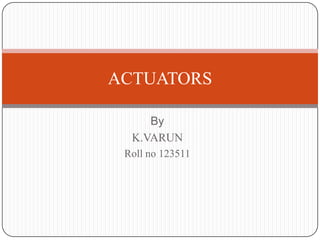
Actuators
- 2. Type of motion Linear Rotary Type of medium Hydraulic pneumatic electrical ACTUATORS
- 3. HYDRAULIC ACTUATORS Hydraulic Actuators are used in industrial process control, employ hydraulic pressure to drive an output member. Principle : Pascal’s Law “Pressure exerted anywhere in a confined incompressible fluid is transmitted equally in all directions throughout the fluid, acts upon every part of the confining vessel at right angles to its interior surfaces”. F = PxA
- 4. WORKING OF HYDRAULIC ACTUATION SYSTEM Case 1 Lever is moved away from valve body Α directional control valve controls the direction of oil flow in the system and, therefore, the direction of motion of the cylinder piston. The valve has four ports, labeled Ρ, Τ, Α, and Β. Ρ and Τ stand for pressure and tank (or reservoir), and Α and Β are output ports. The valve can be operated in three different positions.
- 5. case 2 Lever is moving towards valve body • The oil from the pump flows through path Ρ-Α of the valve to the upper end of the cylinder. • The oil pushes the piston downward, which lowers the attached load. At the same time, the oil at the lower end of the cylinder flows back to the reservoir through path Β-Τ of the directional control valve.
- 6. case 3 : Lever is idle in position • When the directional control valve lever is released, the valve automatically returns to the center (neutral) position. •In this position, all four ports are blocked and oil cannot escape from either side of the cylinder. •. This stops the movement of the piston and causes oil to flow from the pump back to the reservoir through the pressure relief valve.
- 7. PNEUMATIC ACTUATOR A pneumatic actuator converts energy (typically in the form of compressed Air) into motion. The motion can be rotary or linear, depending on the type of actuator. A Pneumatic actuator mainly consists of a piston, a cylinder, and valves or ports. Pneumatic systems are very common, and have much in common with hydraulic systems with a few key differences
- 8. WORKING OF PNUEMATIC ACTUATORS Pneumatic actuators are generally relatively simplistic and depend on their own ability to convert potential energy into kinetic energy.
- 9. Electric Motors Electric motors are the most common source of torque for mobility and/or manipulation in machines. The physical principle of all electric motors is that when an electric current is passed through a conductor (usually a coil of wire) placed within a magnetic field, a force is exerted on the wire causing it to move
- 10. Components Of An Electric Motor The principle components of an electric motor are: North and south magnetic poles to provide a strong magnetic field. Being made of bulky ferrous material they traditionally form the outer casing of the motor and collectively form the stator An armature, which is a cylindrical ferrous core rotating within the stator and carries a large number of windings made from one or more conductors
- 11. Components Of An Electric Motor (cont…) A commutator, which rotates with the armature and consists of copper contacts attached to the end of the windings Brushes in fixed positions and in contact with the rotating commutator contacts. They carry direct current to the coils, resulting in the required motion
- 12. Components Of An Electric Motor (cont…) (Rotating) Commutator Stator Brushes Armature
- 13. How Do Electric Motors Work? The classic DC motor has a rotating armature in the form of an electromagnet A rotary switch called a commutator reverses the direction of the electric current twice every cycle, to flow through the armature so that the poles of the electromagnet push and pull against the permanent magnets on the outside of the motor As the poles of the armature electromagnet pass the poles of the permanent magnets, the commutator reverses the polarity of the armature electromagnet. During that instant of switching polarity, inertia keeps the motor going in the proper direction
- 14. Piezoelectric motor A piezoelectric motor or piezo motor is a type of electric motor based upon the change in shape of a piezoelectric material when an electric field is applied. Piezoelectric motors make use of the converse piezoelectric effect whereby the material produces acoustic or ultrasonic vibrations in order to produce a linear or rotary motion.
- 15. BIMORPH A bi-laminar actuator is made from a piezoelectric smart material that returns to its original shape after a force is to applied to it. “A flexing or bending actuator is designed to produce a relatively large mechanical deflection in response to an electrical signal.” “Two thin strips of piezoelectric ceramic are bonded together, usually with the direction of polarization coinciding, and are electrically connected in parallel.”
- 16. Basic Working Principle (cont.) “When electrical input is applied, one ceramic layer expands and the other contracts, causing the actuator to flex.” + - + - Vin>0V Vin=0V
- 17. MEMS ACTUATORS Thermal Actuators V-Shaped Thermal Actuators These actuators are based on the constrained thermal expansion of the angled beams (a result of Joule heating when a current is passed through the legs of the actuator), resulting in motion of the center shuttle in the direction shown by the arrow in the figure.
- 18. Electrostatic Actuators Torsional Ratcheting Actuator (TRA)
- 19. Cont’d
- 20. REFERENCES W.Bolton; 1995, A Text book on “Mechatronics Electronic Control Systems in Mechanical and Electrical Engineering” Third edition; Pearson Education. “Practical's in Hydraulic Systems” written by Ravi Doddannavar and Andries Barnard, Elsevier Science & Technology Books Publications. The Mechatronics Handbook” written by Robert H. Bishop, The University of Texas at Austin, Texas. Y. Bar-Cohen, Electroactive polymer (EAP) Actuators as artificial muscles. Reality, potential, and Challenges, SPIE Press, Washington, USA (2001). www.nptel.iitm.ac.in http://mechatronics.ece.usu.edu/ece5320/Schedule/h w01-2005/